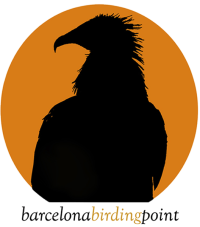About 100.000 passage birds monitored in Barcelona
This autumn, as every autumn since 1998, a group of volunteers have been monitoring diurnal bird migration from a hill near Barcelona. Its name is Turó Blau (Blue Hill) -304 meters a.s.l.. In 2011 monitoring started in August 17th until November 19th monitoring 17.490 birds involving 79 species of birds.

Commoner bird species this year have been Alpine Swift (Apus melba) with 4.440 birds recorded, Chaffinch (Fringilia coelebs) -3.331 individuals-, Barn Swallow (Hirundo rustica) -2.629-, Common House Martin (Delichon urbicum) -2.226- and Common Wood Pigeon (Columba palumbus) -984-.
Honey Buzzard (Pernis apivorus) has been the commonest species of raptor in 2011 -209 individuals. Common Kestrel (Falco tinnunculus) -112, Sparrowhawk (Accipiter nisus) -83, and Western Marsh Harrier (Circus aeruginosus) -60 individuals- and Common Buzard (Buteo buteo) -39 individuals- have the commoner species along the monitoring.
Main highlights this year have included 1 Steppe Buzzard (Buteo buteo vulpinus) -first record since 1998, 9 Eleonora’s Falcon (Falco eleonorae) -highest record in a single season, 2 Merlin (Falco columbarius), 1 Short-eared Owl (Asio flammeus) -first record since 1998, 20 Pallid Swift (Apus pallidus) -highest record in a single season, 1 Red-rumped Swallow (Hirundo daurica), 3 Zitting Cisticola (Cisticola juncidis), 1 Blue Rock Thrush (Monticola solitarius) -third record since 1998- and 1 Dartford Warbler (Sylvia undata) -first record since 1998.

This autumn we have had unusual weather conditions as high temperatures have persisted until October and so on. At the end of September and beginning of October we use to have some rains in Barcelona, quite high humidity levels as well as lower temperatures. But it was no rain this year until November and then we only got three days of intense rain. Lower temperatures appeared around 17th October (when many passerines passed over me coming from Northern nesting sites) but around 10th November I was monitoring birds wearing two thin t-shirts. Thought I normally use to wear gloves and scarf at this time.
Monitoring begun in autumn of 1998. Since that day 99.320 birds have been monitored in Turó Blau involving 116 species of birds, 25 of them being raptors.
The more common group of birds are passerines, totalling 52.268 birds, followed by swifts (19.326 birds), raptors (7.887 individuals) and pigeons (6.783 individuals). Chaffinch has been the commonest species all these years totalling 26.858 birds, more than a quarter of all monitored birds.
WHEN?
Not all species move South at the same time. Every species has its season and most of the commoner have an important peak moving at least a 30% of their total.
There’s a group of species that clearly pass South in September: most of the raptors, including Honey Buzzard, Marsh Harrier and Sparrowhawk, but also Bee-eaters (a rare species to be seen after September 20th), Swallows and some passerines as Tree Pipit, Yellow Wagtail and the scarce Tawny Pipit.
SPECIES PEAK IN PASSAGE
Honey Buzzard (Pernis apivorus) September 20-27th
Eurasian Sparrowhawk (Accipiter nisus) about September 10th
Marsh Harrier (Circus aeruginosus) about 20-25 September
Common Kestrel (Falco tinnunculus) late September – early October
Hobby (Falco subbuteo) about 20th September
Alpine Swift (Apus melba) about October 18th
Common Chaffinch (Fringilla coelebs) about October 23 th
Common Wood Pigeon (Columba palumbus) October 15-20th
Linnet (Carduelis cannabina) about October 10-15th
Dunnock (Prunella modularis) about October 20th
Song Thrush (Turdus philomelos) about October 12-15th

In fact, we can say most of the species of raptors leave in September with few species moving in October (Common Buzzard, Hen Harrier and Common Kestrel). About passerines is opposite as most of their passage become important from October 10 onwards. In general, the African wintering species use to move South earlier than those wintering around the Mediterranean or in Catalonia itself. Thus, Common Switf (Apus apus) leaves about August 20th (the first species to move South) while common winter species around Barcelona appear in mid, late October (Common Buzzard, Common Kestrel, Merlin, Song Thrush, Mistle Thrush, Common Chaffinch, Dunnock). There’s only one species that break down this behaviour; that is Alpine Swift, tropical Africa wintering species with its passage peak in late October.

